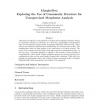Free Online Productivity Tools
i2Speak
i2Symbol
i2OCR
iTex2Img
iWeb2Print
iWeb2Shot
i2Type
iPdf2Split
iPdf2Merge
i2Bopomofo
i2Arabic
i2Style
i2Image
i2PDF
iLatex2Rtf
Sci2ools
CLEF
2009
Springer
2009
Springer
MorphoNet: Exploring the Use of Community Structure for Unsupervised Morpheme Analysis
This paper investigates a novel approach to unsupervised morphology induction relying on community detection in networks. In a first step, morphological transformation rules are automatically acquired based on graphical similarities between words. These rules encode substring substitutions for transforming one word form into another. The transformation rules are then applied to the construction of a lexical network. The nodes of the network stand for words while edges represent transformation rules. In the next step, a clustering algorithm is applied to the network to detect families of morphologically related words. Finally, morpheme analyses are produced based on the transformation rules and the word families obtained after clustering. While still in its preliminary development stages, this method obtains encouraging results at Morpho Challenge 2009, which demonstrate the viability of the approach. Categories and Subject Descriptors I.2 [Artificial Intelligence]: I.2.6 Learning; I.2...
CLEF 2009 | Information Technology | Morphological Transformation Rules | Morphology Induction | Transformation Rules |
| Added | 08 Nov 2010 |
| Updated | 08 Nov 2010 |
| Type | Conference |
| Year | 2009 |
| Where | CLEF |
| Authors | Delphine Bernhard |
Comments (0)

